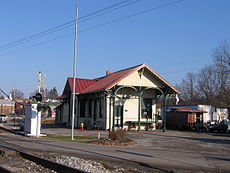Pittsburgh and Western Railroad
 The Mars railroad station in Mars, Pennsylvania is one of the last stations still standing that was built by the P&W Railroad. | |
| Overview | |
|---|---|
| Headquarters | Pittsburgh, Pennsylvania |
| Locale | Northwestern Pennsylvania |
| Dates of operation | 1873–1911 |
| Successor | Baltimore and Ohio Railroad |
| Technical | |
| Track gauge | 4 ft 8+1⁄2 in (1,435 mm) standard gauge |
| Previous gauge |
|
| Length | 200 miles (320 km) (approximate) |
The Pittsburgh and Western Railroad (reporting mark PW) was a nineteenth-century, 3 ft (914 mm) narrow gauge railroad connecting Pittsburgh with coal supplies and the oil field around Titusville, Pennsylvania.[1] Its right-of way formed the main line of the Baltimore and Ohio Railroad west from Pittsburgh. It was reorganized in 1889 under Malcolm A. McDonald.[2]
The railroad constructed another 3 ft (914 mm) narrow gauge line from Callery Junction to Foxburg, Pennsylvania. This line would later become known as the Northern Subdivision of the Baltimore and Ohio Railroad (B&O). In 1883 the railroad took control of the line from Foxburg to Mount Jewett after the Pittsburgh, Bradford and Buffalo Railroad had financially flopped. The railroad would later merge with the Bradford, Bordell and Kinzua Railroad, and the Big Level and Kinzua Railroad. These mergers would prove to be ineffective; by 1902 these joint railways were in financial ruin.
In 1902, the Baltimore and Ohio Railroad (B&O) took control of the P&W. By 1911, the P&W was dissolved, and the B&O took over all operations. That same year, most of the narrow gauge was converted to 4 ft 8+1⁄2 in (1,435 mm) standard gauge track. The B&O would continue to operate the line until 1982 when it was acquired by Sloan Cornell of the Knox and Kane Railroad.[3]
Trackage between Ribold and Butler, Pennsylvania, as well as the Petrolia Branch is used by the Buffalo and Pittsburgh Railroad. The Clarion Junction-Kane section ceased operations in 2006; it was abandoned in 2008 when the Knox and Kane Railroad was sold at auction.
See also
References
- ^ Hilton, George Woodman (1990). American Narrow Gauge Railroads. pp. 494–495. ISBN 978-0-8047-1731-1. Retrieved 2008-12-31.
- ^ "Pittsburg and Western" (PDF). New York Times (Oct 29). 1889. Retrieved 2009-01-01.
- ^ Burns, Robert W. Ex-Baltimore & Ohio Lines in Northwestern Pennsylvania. pp. 2–5.
Further reading
- Burns, Robert W., Ex-Baltimore & Ohio Lines in Northwestern Pennsylvania, Robert W. Burns, 1999.
- History of Allegheny County, Pennsylvania
- Defunct Ohio railroads
- Defunct Pennsylvania railroads
- Transportation in Pittsburgh
- Narrow gauge railroads in Pennsylvania
- 3 ft gauge railways in the United States
- Predecessors of the Baltimore and Ohio Railroad
- Railway companies established in 1879
- Railway companies disestablished in 1887
- Railway companies established in 1902
- American companies disestablished in 1887
- American companies established in 1879
